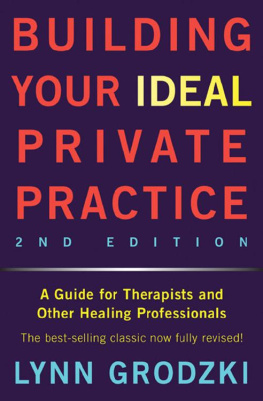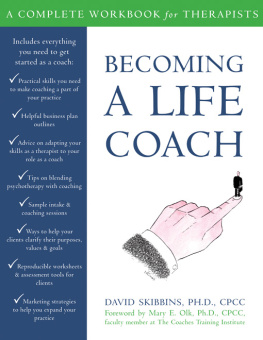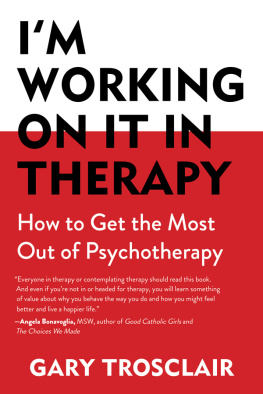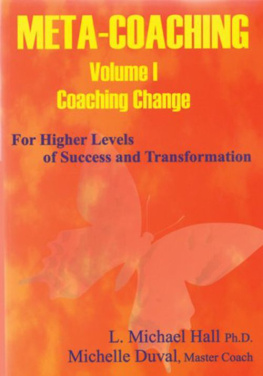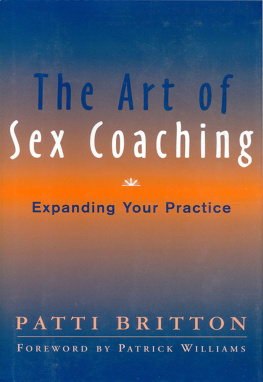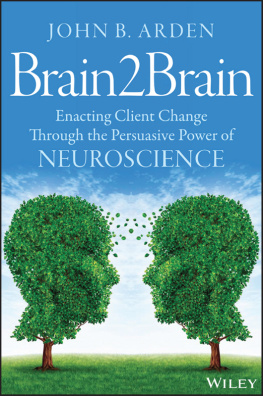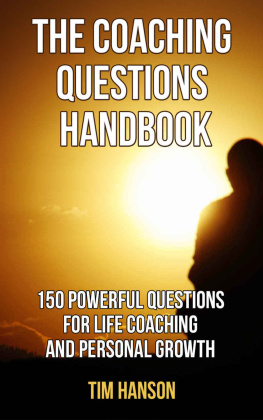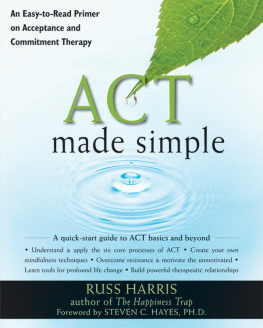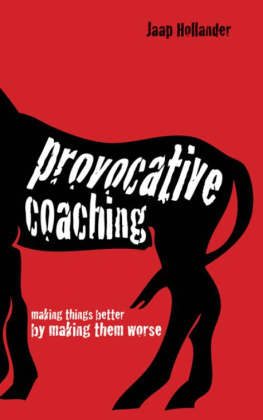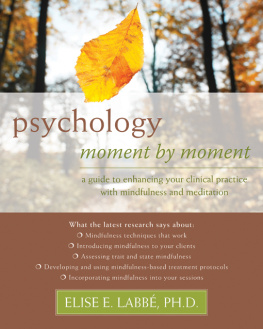
Therapy with a Coaching Edge
Therapy with a
Coaching Edge
Partnership, Action, and
Possibility in Every Session
Lynn Grodzki

W. W. Norton & Company
Independent Publishers Since 1923
New York London
A NORTON PROFESSIONAL BOOK
Note to Readers: Standards of clinical practice and protocol change over time,
and no technique or recommendation is guaranteed to be safe or effective in all circumstances. This volume is intended as a general information resource for professionals practicing in the field of psychotherapy and mental health; it is not a substitute for appropriate training, peer review, and/or clinical supervision. Neither the publisher nor the author(s) can guarantee the complete accuracy, efficacy, or appropriateness of any particular recommendation in every respect.
Copyright 2018 by Lynn Grodzki
All rights reserved
First Edition
For information about permission to reproduce selections from this book, write to
Permissions, W. W. Norton & Company, Inc., 500 Fifth Avenue, New York, NY 10110
For information about special discounts for bulk purchases, please contact
W. W. Norton Special Sales at specialsales@wwnorton.com or 800-233-4830
Production manager: Christine Critelli
Cover design by Adly Elewa
The Library of Congress has cataloged the printed edition as follows:
Names: Grodzki, Lynn, author.
Title: Therapy with a coaching edge : partnership, action and possibility in
every session / Lynn Grodzki.
Description: First edition. | New York : W W Norton & Company, 2018. |
Series: A Norton professional book | Includes bibliographical references.
Identifiers: LCCN 2017050184 | ISBN 9780393712476 (hardcover)
Subjects: LCSH: PsychotherapyPractice. | Personal coaching. |
Psychotherapist and patient.
Classification: LCC RC465.5 .G764 2018 | DDC 616.89/140068dc23 LC record available at https://lccn.loc.gov/2017050184ISBN: 978-0-393-71247-6
ISBN 978-0-393-71248-3 (e-book)
W. W. Norton & Company, Inc., 500 Fifth Avenue, New York, N.Y. 10110
www.wwnorton.com
W. W. Norton & Company Ltd., 15 Carlisle Street, London W1D 3BS
T his has been a compelling, yet challenging book for me to write. The biggest help to me in this endeavor has also been the closest to homemy husband, Tadnot a therapist himself, but a careful reader and thoughtful editor. He has been willing to think and read and talk about this manuscript with me endlessly during the past two years, through all the early and very rough drafts. Tad understands that I can be uncommunicative when I am writing, consumed with my own thoughts. When I would finally emerge after hours at my computer, we took long walks in the nearby park. He was a good listener as I debriefed, needing to assess chapters and consider changes. His genuine interest in the topic grew over time and lessened the isolation so common with writing; he allowed the books development to be a bond between us, rather than a block. After almost 30 years of marriage, I appreciate that this venture could help us turn toward each other, as John Gottman likes to say, rather than turn away.
I also thank Rich Simon, editor of Psychotherapy Networker magazine, for his support in publishing an early version of this model in 2012 as The Coaching Edge. Carol and Tom Walsh, two dear friends and savvy therapists, agreed to be early readers and gave me valuable, clear feedback so that I could make this manuscript more relevant.
This book is in your hands because of Deborah Malmud, director of the Professional Books Division at W. W. Norton, who is a gem of an editor. The publishing industry often falls victim to instability, as publishing companies rise and tumble, so I know that the consistently supportive relationship I have had with Deborah is rare. I am lucky to have had her in my corner for the past 18 years, during which time we produced 6 books (and one major revision of my first book, so really 7 books, if anyone but me is counting). It was Deborah who encouraged me to tackle this project and kept it alive as an idea. I am glad she stayed true to the need for this book. Now that it is written, I think she was right: This model seems like a natural evolution of proactive therapy, especially for the next generation of therapists and counselors who are practicing in the midst of much change and uncertainty. If this book or any of my earlier ones have been helpful or useful to you, please thank Deborah Malmud.
I n 2010, I began to notice that my normal way of working as a therapist was changing. I was curious about the change, but in no way worried. It was interesting, in the way that it interests me to walk out into my garden and see the emergence of a new plant sprouting up, a volunteer perennial that I did not add to the border but welcome as a garden bonus.
Perhaps my clinical work is undergoing a similar blossoming, I thought. As a therapist who is eclectically trained, I have gone through several shifts in methods during the course of 30 years of practice, but most of these have been intentional. This shift arrived unplanned, outside of my awareness. The good news was that client outcomes were improving. People I saw were getting better, faster. I was curious and wondered why.
By the time I talked to Rich, later that year, my thoughts had clarified somewhat. Rich Simon, the publisher of Psychotherapy Networker magazine, occupies a very special place in my life. He is the one person I can count on to push me beyond my professional comfort level. Every year or so, Rich contacts me to find out what I am thinking about. Lets chat, he says, an innocent-sounding invitation by email that belies what I now know will be a fast-paced, invigorating conversation. I come to these chats ready to take notes. Rich is provocative, prodding me to think and then articulate what I am only vaguely grasping about my own work.
Rich knows me best in my role as a business coach, but in this particular conversation, I explained to Rich that over several years, something was surfacing in my work as a therapist. I suspected I was experiencing a synergy of sorts, based on operating two separate practices, therapy and coaching, in a side-by-side small business. My methods were blurring. Because I was working full time as both a psychotherapist and a business/life coach, my clinical skills had morphed. Without intending to, when I was doing psychotherapy with certain clients, I was working more quickly. I challenged them to have a bigger life plan. I talked about possibility instead of pathology. I focused on success factors more than symptoms. Sometimes I made big requests of clients for significant action between sessions, and they worked hard to comply. In sessions, my clients were still expressing a full range of feelings and thoughts, and we addressed difficult issues and problems. But they also seemed to be enjoying themselves more. We laughed. We bantered. This proactive persona was one I often used as a coach.
I am a master certified coach, and I teach coaching to new coaches as a faculty member for a large accredited coaching school. I knew I wasnt using a true coaching protocol or pure coaching skills in therapy sessions. What occurred in therapy did not mirror what I did in my role as a coach. Instead, I had developed an adaptation for psychotherapy, a way of relating that I might at best call coach-like. I had embraced a coach-like persona and adapted some coach-like techniques and skills. The results were promising. I saw improved client motivation toward goals. Clients made results that they could identify within a single session, session after session. A faster pace in client outcomes occurred with both new and existing clients.
Next page

